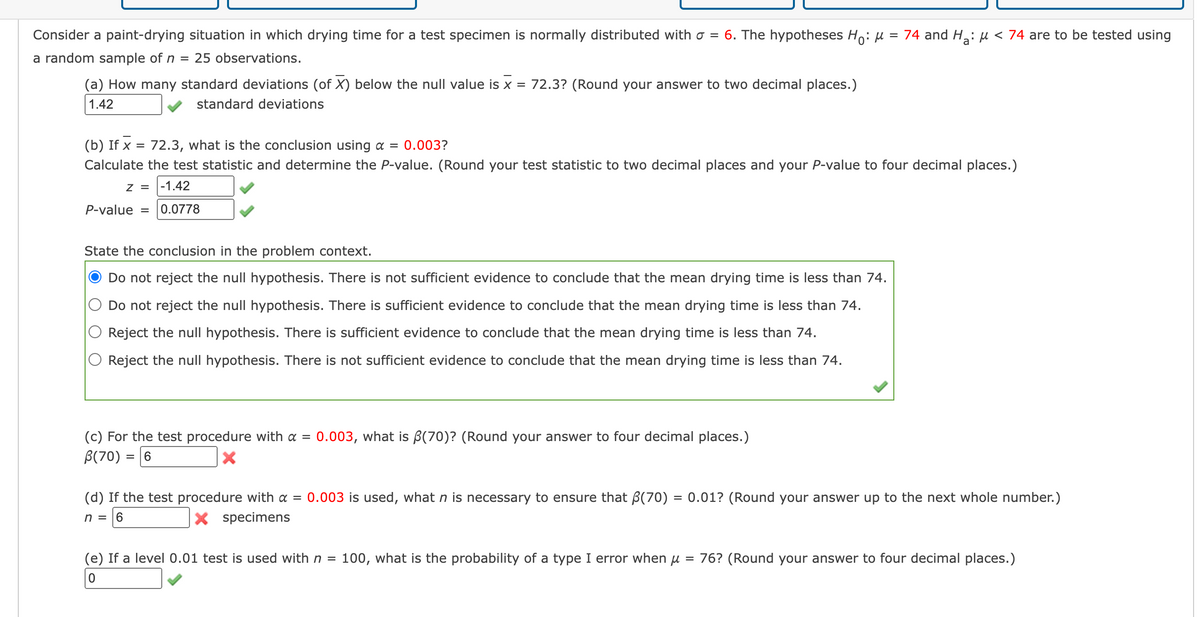Consider a paint-drying situation in which drying time for a test specimen is normally distributed with a = 6. The hypotheses Ho: M = 74 and Ha: < 74 are to be tested using a random sample of n = 25 observations. (a) How many standard deviations (of X) below the null value is x = 72.3? (Round your answer to two decimal places.) 1.42 standard deviations (b) If x= 72.3, what is the conclusion using α = 0.003? Calculate the test statistic and determine the P-value. (Round your test statistic to two decimal places and your P-value to four decimal places.) z = -1.42 P-value 0.0778 State the conclusion in the problem context. Do not reject the null hypothesis. There is not sufficient evidence to conclude that the mean drying time is less than 74. O Do not reject the null hypothesis. There is sufficient evidence to conclude that the mean drying time is less than 74. O Reject the null hypothesis. There is sufficient evidence to conclude that the mean drying time is less than 74. O Reject the null hypothesis. There is not sufficient evidence to conclude that the mean drying time is less than 74. (c) For the test procedure with a = 0.003, what is ß(70)? (Round your answer to four decimal places.) B(70) = 6 X (d) If the test procedure with a = 0.003 is used, what n is necessary to ensure that 3(70) = 0.01? (Round your answer up to the next whole number.) n = 6 X specimens (e) If a level 0.01 test is used with n = 100, what is the probability of a type I error when μ = 76? (Round your answer to four decimal places.) 0
Consider a paint-drying situation in which drying time for a test specimen is normally distributed with a = 6. The hypotheses Ho: M = 74 and Ha: < 74 are to be tested using a random sample of n = 25 observations. (a) How many standard deviations (of X) below the null value is x = 72.3? (Round your answer to two decimal places.) 1.42 standard deviations (b) If x= 72.3, what is the conclusion using α = 0.003? Calculate the test statistic and determine the P-value. (Round your test statistic to two decimal places and your P-value to four decimal places.) z = -1.42 P-value 0.0778 State the conclusion in the problem context. Do not reject the null hypothesis. There is not sufficient evidence to conclude that the mean drying time is less than 74. O Do not reject the null hypothesis. There is sufficient evidence to conclude that the mean drying time is less than 74. O Reject the null hypothesis. There is sufficient evidence to conclude that the mean drying time is less than 74. O Reject the null hypothesis. There is not sufficient evidence to conclude that the mean drying time is less than 74. (c) For the test procedure with a = 0.003, what is ß(70)? (Round your answer to four decimal places.) B(70) = 6 X (d) If the test procedure with a = 0.003 is used, what n is necessary to ensure that 3(70) = 0.01? (Round your answer up to the next whole number.) n = 6 X specimens (e) If a level 0.01 test is used with n = 100, what is the probability of a type I error when μ = 76? (Round your answer to four decimal places.) 0
A First Course in Probability (10th Edition)
10th Edition
ISBN:9780134753119
Author:Sheldon Ross
Publisher:Sheldon Ross
Chapter1: Combinatorial Analysis
Section: Chapter Questions
Problem 1.1P: a. How many different 7-place license plates are possible if the first 2 places are for letters and...
Related questions
Question
Need ans for wrong all.

Transcribed Image Text:Consider a paint-drying situation in which drying time for a test specimen is normally distributed with a = 6. The hypotheses Ho: μ = 74 and H₂: μ< 74 are to be tested using
a random sample of n = 25 observations.
(a) How many standard deviations (of X) below the null value is x = 72.3? (Round your answer to two decimal places.)
1.42
standard deviations
(b) If x = 72.3, what is the conclusion using a = 0.003?
Calculate the test statistic and determine the P-value. (Round your test statistic to two decimal places and your P-value to four decimal places.)
Z = -1.42
P-value = 0.0778
State the conclusion in the problem context.
Do not reject the null hypothesis. There is not sufficient evidence to conclude that the mean drying time is less than 74.
Do not reject the null hypothesis. There is sufficient evidence to conclude that the mean drying time is less than 74.
Reject the null hypothesis. There is sufficient evidence to conclude that the mean drying time is less than 74.
Reject the null hypothesis. There is not sufficient evidence to conclude that the mean drying time is less than 74.
(c) For the test procedure with a = 0.003, what is ß(70)? (Round your answer to four decimal places.)
B(70) = 6
X
(d) If the test procedure with a = 0.003 is used, what n is necessary to ensure that (70) = 0.01? (Round your answer up to the next whole number.)
X specimens
n = 6
(e) If a level 0.01 test is used with n = 100, what is the probability of a type I error when u 76? (Round your answer to four decimal places.)
Expert Solution
This question has been solved!
Explore an expertly crafted, step-by-step solution for a thorough understanding of key concepts.
This is a popular solution!
Trending now
This is a popular solution!
Step by step
Solved in 2 steps with 2 images

Recommended textbooks for you

A First Course in Probability (10th Edition)
Probability
ISBN:
9780134753119
Author:
Sheldon Ross
Publisher:
PEARSON


A First Course in Probability (10th Edition)
Probability
ISBN:
9780134753119
Author:
Sheldon Ross
Publisher:
PEARSON
